(The 2008 Vermont 100 is this weekend. I’ve entered this race twice, in 2004 and 2005. Here’s something from the archives regarding my first attempt.)
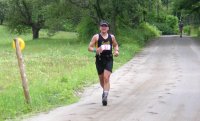 The weekend of July 17, 2004, I went to Woodstock, Vermont to run in the 16th annual Vermont 100. Over 300 people had signed up to run the race, along with a number of horses and their riders who were competing in the associated endurance ride.
The weekend of July 17, 2004, I went to Woodstock, Vermont to run in the 16th annual Vermont 100. Over 300 people had signed up to run the race, along with a number of horses and their riders who were competing in the associated endurance ride.
My main goal in the race was to finish, which would be challenge enough. There’s a 30 hour cutoff, so if you don’t finish by then (or if you drop below a 30 hour pace along the way), your race is over. If you finish under 24 hours, you win a belt buckle, and I thought that that I’d have a reasonably good chance of “buckling”, but I wasn’t counting on it.
The course is a 100 mile loop through the mountains of southern Vermont, with about 70 miles on dirt roads and jeep paths, a few small sections on paved roads, and the remainder on mountain trails. There are 33 aid stations along the way where runners can pick up a variety of fluids, foods, or medical supplies, including ten stations where you could meet with your handlers (or access your drop bags) and stock up on your personal supplies.
I had done my last long run six weeks before. It was about 38 miles, which included the Rock and Roll Marathon in San Diego. Three weeks before Vermont, I set a new 10K PR at Whirlaway, which wasn’t really relevant to the 100 miler, but was nice anyhow. Two weeks before, I did one last 22 mile run. The last two weeks I rested, running no more than six miles in a day (usually only four) every other day.
During that extended taper, I’d been getting my hair cut shorter and shorter. Tuesday the week of the race, I got my final race haircut, shorter than I’d ever had it cut since my parents were telling the barber what to do. The short haircut does have some practical use, as it helps keep me a bit cooler. There’s also a side benefit in that the change in my appearance helps me focus on the goal. It’s something I’ve done for other races, but never to the same extent. I know it’s silly, but every little edge helps!
Finally, the time came to leave for Vermont. Doreen, my wife, wasn’t going up with me, so I left from work mid-day Thursday for the motel in Woodstock. The motel had twelve rooms, about half of which were taken by other runners. Many of the runners had been coming back for the race year after year. I was talking with the owner, her daughter, and one running couple who had first stayed there 12 years ago, when the owner had just learned she was pregnant with her daughter. Those runners have been there every year since.
Friday morning, I ate breakfast and then went to the start at Silver Hill Meadow to register and turn in the donations I’d collected for Vermont Adaptive Ski & Sports (in all, about $1200 – thanks to those who contributed!). The organizers had mowed out a wide space for the use of the race and the competitors. In the middle of the space, there were a few large tents for use by the race. To either side, there were numerous smaller tents and campers set up by the runners camping out at the start, and small grazing areas staked out for each horse that would be participating, along with the horses’ trailers and a tent or camper for the riders and their friends.
First, I went in the main tent, picked up my number and t-shirt, and turned in my donations. While registering, I ran into Gaynor Bourgeois, someone who’d I’d met in two previous 50Ks in Virgina/West Virginia (ultrarunning is a fairly small world), including the time we’d gotten lost together within 2 miles of the start of one race. This was also her first 100. Then I went to get weighed in. During the race there are three medical checks (and an additional voluntary check) where you are weighted to ensure that you haven’t lost (due to dehydration) or gained (due to hyponatremia) a dangerous amount of weight. I weighed in at 151 pounds.
Then, I dropped by Jeff Washburn’s trailer to say hi. Jeff is a member of Gil’s Athletic Club, a trail running group in Topsfield, MA. We both belong to an ultra mailing list, and Jeff had invited all the members to drop by while up in Vermont. He’s a veteran of a number of ultras, so I picked his brain (and drank his root beer) for awhile.
When I finished, I returned to town for lunch (pasta, of course) and then tried to decide which shoes to wear. I had five pairs with me, two pairs of New Balance 706 trail shoes (one 2E width, one 4E), a pair of NB 827 road shoes, a pair of Nike Skylons, and a pair of NB 870 trail shoes that I’d bought on the trip to Vermont. From the course description, it didn’t seem like trail shoes were necessary, and I wanted the additional cushion of a road shoe. I’d been running in NB 828s and then 827s for over 30 pairs, but they’d recently been discontinued. The pair of 827s was my last pair and a bit too small as my feet had spread some recently with all the training. I’d been having trouble finding tolerable replacements, with the Skylons as the latest attempt, but I didn’t have faith in them. I wasn’t quite stupid enough to try the 870s for the first time in a 100 mile race, so I settled on the 2E 706s for the start.
After finally deciding, I rested until it was time to return to the start for the 4PM pre-race meeting. At the meeting, we went over the rules for handlers, who were supposed to follow specific routes around the course to avoid runners and keep from annoying the locals. We were also treated to a description of the course, but that was basically useless, being twenty minutes of “and then you go up the hill, down, and then up again.”
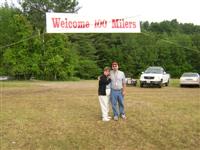 I skipped the pre-race dinner on the meadow and ate dinner in town so I’d be sure to be back at the hotel in time to meet with my crew, Mark Bates and Karen Mattson, who were arriving that evening after work. They arrived about 7:30, and we went over the plans for the next day. They were to meet me for the first time during the race at the first handler’s aid station, which would allow them to get a bit more rest for the long day ahead, so we loaded their car with my supplies, except for what I’d need before the start. Then Mark and Karen went to Karen’s parents’ in Claremont, NH to sleep. I was in bed and asleep, with three alarms set (just in case) by 10PM.
I skipped the pre-race dinner on the meadow and ate dinner in town so I’d be sure to be back at the hotel in time to meet with my crew, Mark Bates and Karen Mattson, who were arriving that evening after work. They arrived about 7:30, and we went over the plans for the next day. They were to meet me for the first time during the race at the first handler’s aid station, which would allow them to get a bit more rest for the long day ahead, so we loaded their car with my supplies, except for what I’d need before the start. Then Mark and Karen went to Karen’s parents’ in Claremont, NH to sleep. I was in bed and asleep, with three alarms set (just in case) by 10PM.
At 2AM, the first of the alarms work me up. I showered, dressed, and had a cup of coffee to wake up, a PowerBar Harvest Bar, and a few glasses of Gatorade to get started on food and fluids. I started to eat a Slim Jim for some protein, but didn’t finish it, a portent of things to come.
My attire, along with the body lube and nipple guards, and two ibuprophen and a Sudafed before starting, was pretty much what I’ve used at marathons, with the usual addition for ultras of some tape around my calves to keep them from scraping raw when they’re clipped by my heels. There was one minor variation. I wear a Compeed pad on the ball of my right foot to prevent blisters, but I knew that the pad would come off well before 100 miles had passed, so I coated the area with tincture of benzoin before applying the Compeed to help it adhere better.
At 3AM, I left for the start. It took about a half-hour to get to the dimly lit meadow. I parked and wandered over to the tent to wait for the start. It was more than warm enough already to hang out in just my running outfit, which didn’t bode well for later in the day.
Finally, the waiting was over. Just before 4AM, we lined up in the field behind a banner over the starting line (the horses started an hour later, at 5AM). This was still before dawn, though there was a hint of light in the eastern sky. I went to the rear of the pack, where I met Chris Martin, another ultra list denizen who’d given me some advice in the past. We both stayed at the back, and at 4, we were off.
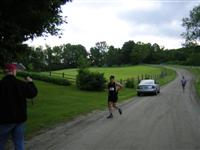 My plan was to walk up the hills, and run the flats and downhills. I’d take a Succeed cap (electrolytes) and some carbohydrate gel every half hour, and two ibuprophen every third hour, and I’d drink along with those, and whenever else I thought about drinking. I had a water bottle belt which holds two 16/20 ounce bottles, plus it had pockets for the pills and assorted supplies I wanted to carry along (extra body lube, blister patches, etc…). I had two gel flasks, one in the clip in front, and a spare stored in the pouch in back. I’d reload on fluids and snack on the food at the aid stations, and reload with pills and get extra supplies (shoes, socks, lights, …) when I met Mark and Karen at the handler stations.
My plan was to walk up the hills, and run the flats and downhills. I’d take a Succeed cap (electrolytes) and some carbohydrate gel every half hour, and two ibuprophen every third hour, and I’d drink along with those, and whenever else I thought about drinking. I had a water bottle belt which holds two 16/20 ounce bottles, plus it had pockets for the pills and assorted supplies I wanted to carry along (extra body lube, blister patches, etc…). I had two gel flasks, one in the clip in front, and a spare stored in the pouch in back. I’d reload on fluids and snack on the food at the aid stations, and reload with pills and get extra supplies (shoes, socks, lights, …) when I met Mark and Karen at the handler stations.
The race went pretty well for the first 40 miles. The “flats” were pretty much non-existent as the hills were relentless. Throughout that time, I’d pass people while I was running, but be passed by them as we walked, as my walk was slower than everyone’s around me. I was running at about an 8:30-9 min./mile pace, which is my slow, comfortable pace when I’m starting out. I expected that to slow down over time.
You’d expect that at these easy paces, people would spend time running together and talking. There was some of that, but most of the time people weren’t adjusting their pace to stay with other runners. So you’d talk with someone for a few minutes, as you (or they) slowly caught up and passed, but as leisurely as it seemed, everyone was racing so we mostly went on at our own pace.
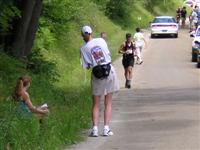 By the aid station at mile 45, I was almost 2 hours ahead of the pace for a 24 hour finish. But that was the peak, as far as my time was concerned. By then, the 20+ miles of downhills had done a job on my quads. I was still running as planned, but there was considerable pain involved. Also, I don’t remember when my stomach started bothering me, but it was early in the race. Whenever I looked at food, I rebelled at the idea of eating any so I was depending on my gel and drinks for calories. I had a bit of peanut butter sandwich early and a bit of chicken and some soup later on, and that’s nowhere near enough solid food. The stomach problems may have been due to the coffee, the ibuprophen, not enough electrolytes, or something else, but I never did solve them.
By the aid station at mile 45, I was almost 2 hours ahead of the pace for a 24 hour finish. But that was the peak, as far as my time was concerned. By then, the 20+ miles of downhills had done a job on my quads. I was still running as planned, but there was considerable pain involved. Also, I don’t remember when my stomach started bothering me, but it was early in the race. Whenever I looked at food, I rebelled at the idea of eating any so I was depending on my gel and drinks for calories. I had a bit of peanut butter sandwich early and a bit of chicken and some soup later on, and that’s nowhere near enough solid food. The stomach problems may have been due to the coffee, the ibuprophen, not enough electrolytes, or something else, but I never did solve them.
The 45 mile aid station was a handler station, so I made my first shoe change. I went to the NB 827s, thinking the additional cushioning might help with the encroaching wear and tear. This turned out to be a mistake. The shoes were already a bit short, and the 45 previous miles hadn’t helped keep the size of my feet down. So my toes, especially the two big toes, took a beating over the next 11 miles, until the next handler’s station.
There, for the first time, I sat down to rest some rather than reloading and plugging on. By this time, it was past 2PM, and the heat of the day had taken a toll in addition to all the miles. It got up into the 80s at times, though the weather wasn’t too bad for July. A bit warm, and some other runners hit thunderstorms (I never saw more than a few sprinkles, and the leftover puddles).
Anyhow, I was hot, tired, sweaty, and covered with bugs. Thoughts of dropping out began to enter my mind. My time for the 11 miles from the previous handler’s station had risen above the 24 hour pace. I was still almost two hours ahead of that pace overall, but between the pain and the reduced pace, it was obvious that the second half of the race wasn’t going to go as well as I had hoped. I knew that I could keep going, but the remaining 45 miles seemed like an awful long way, especially considering how I already felt. While sitting there, my left adductor began to cramp up, so I decided to take two caps every half hour to help counteract that.
 Mark was talking about running along with me for a bit later on in the day, starting at about 68 miles, unaware of my doubts at this point. I decided to get going and reassess the next time I saw my handlers, in about five miles. I changed into the Skylons, which I still wasn’t sure of, but at least they were longer, so there’d be more toe room. Then I left.
Mark was talking about running along with me for a bit later on in the day, starting at about 68 miles, unaware of my doubts at this point. I decided to get going and reassess the next time I saw my handlers, in about five miles. I changed into the Skylons, which I still wasn’t sure of, but at least they were longer, so there’d be more toe room. Then I left.
It was uphill leaving the station, so I was walking when a couple of horses passed. One of the riders told me to look forward to the view at the end of the climb. I immediately focused on the important word there – “climb”. It turns out that the entire three miles to the next aid station was uphill, in the worst heat of the day. The view at the top was wonderful, but I couldn’t care less. The aid station at the top was unmanned, so there wasn’t anyone to cheer us up.
A couple of uncomfortable downhill miles later, on what were by now quadburgers, and I was at the 60 mile handler’s station. There I made my final shoe change, to the 4E 706s, since my feet were even more uncomfortable in the Skylons, as impossible as that seemed. I also got a facewash from one of the GAC handlers. Much earlier in the race, I’d seen him wiping off their runners with a terrycloth mitt soaked in icewater. At the time, he couldn’t accommodate me, but he remembered and when he did get to me, the cool, clean feeling was incredible! At this point, it was about 5:30PM, so the heat of the day was fading away too.
By now, the pauses at the handlers’ stations, where Mark and Karen had a chair for me to rest in, were stretching to 15 minutes. All day long, they had everything ready so I could rush through the aid station if I wanted to, but as time passed, sitting for awhile seemed like a good option. The rest didn’t really allow for much recovery, but it did help some physically. Of course, it did allow significant time for internal discussion, while I sat there panting (in spite of the slow pace), staring off into space. I was still struggling with doubts, but I broke it down. A little over eight miles to the next handlers’ station. That seemed do-able. Then another 8 miles with Mark, which would be a change from running by myself. Then, there’d only be about 23 miles to go. None of those seemed impossible, when broken down that way, just not very pleasant. As long as I didn’t think too much about the number of miles I’d already come. Oh well, on we go.
Another eight miles of up and down. Time was passing fairly quickly, though the miles were not. I was getting a bit sloppy with the half-hourly consumption of gel and electrolytes, as just keeping going was taking up more of my attention. Still, my weight was good, so I assumed I was doing OK.
Somewhere along here, I met up with Gaynor Bourgeois again, which sparked my competitiveness a little. We went back and forth through a long downhill stretch, until I led her into the handler’s station at mile 69, still about an hour ahead of 24 hour pace. Here I had another rest, another internal dialog, and a bit of soup, which still wasn’t appealing but was better than nothing, and just the idea of dry food was nauseating. It was getting towards evening, so I put on my headlamp and packed a spare hand light and some extra batteries. Other runners were picking up their pacers for the last 31 miles at this station. When I took off, this time Mark came along, but he was only running for the eight miles until the next handlers’ station.
We left about the same time as Gaynor, and together, we all walked up a long stretch of rough trail. Gaynor pulled away when we started running again after reaching the top (she finished more than two hours ahead of me). It was getting dark as the course rolled up and down through the edge of some woods, so we turned on our lights so we could see while under the trees. Soon we needed the lights the whole time. The last horse passed us at about this time.
By now, I was walking the uphills, then walking on after the peak to look at the downhills before beginning to run again. Each downhill step was tearing a bit more out of my quads, muscle fiber that I didn’t have to spare. At the bottom and along what level course there was, I was sneaking in more and more walking. I went a little faster with Mark along than I might have otherwise, but I still slowed dramatically during this leg of the race.
We hit a pleasantly soft horse trail and then began climbing steadily again. By now it was completely dark. As we went along, I was being bombarded by moths. Since my light was strapped to my head, the moths were incredibly annoying. Mark had a hand light, and also the moths weren’t attacking his light nearly as much. We figured that it was probably because his light was dimmer, so I turned my light down. The brighter light really wasn’t necessary at our current pace, and turning it down did help with the moths. Also, the course was marked with glow sticks in addition to the yellow plates used during the day, so the light was mostly needed for footing, rather than to find the next trail marker.
We finally reached the next handlers’ station at about 77 miles. I was still a few minutes ahead of 24 hour pace, but I was pretty much done. The thoughts of dropping out were much louder now, and their arguments were better. I sat down to rest and soon began shivering. Karen went and got my shirt, but I figured I’d warm up if I started up again, so I didn’t put it on at first. I’d get up to think about proceeding, but my legs were stiffening up now as I sat, so I’d stagger around for a few steps, and then sit again. Clearly if I went on, there’d be little, if any, running, and walking 23 miles when I was already beat was not something I was looking forward to at all. In either case, I’d want the shirt, so I put it on.
The internal debate was pretty obvious to any external observers. Mark said that he and Karen weren’t going to be the ones to say I should quit. That didn’t help much, but it did keep the debate going. I stumbled around more, then Mark said something that did help, that anyone could sign up for a race, but that the glory went to those who finished. Trite, but it was enough to inspire me to make up my mind to keep going, in spite of the long, tedious effort that would mean.
So I left. Unfortunately, the course through the aid station and away led gently downhill, which was most uncomfortable. As I was getting going, I was listing a bit to one side and the other as I weaved through the crowd. A few people asked if I needed anything with a “he doesn’t look so good” look on their face, but they didn’t have any spare legs on hand, and my responses appeared coherent enough, so they let me go on.
After awhile I loosened up a tiny bit and settled into a steady pace. I could still climb just about as well as I’d been doing, but I was reduced to an uncomfortable semi-stagger going down. I tried running a few times on the flatter parts of the course, but went no more than a few steps before giving up on that idea. There didn’t seem any danger that I’d collapse, but it was a very long, lonely 12 mile walk on almost totally empty roads and trails through the night, broken up a couple of times by aid stations and a couple of times as someone went by (I definitely wasn’t catching anyone!). I did go back and forth slowly with Vince Devlin, who’d pass me walking, but would stay in the aid stations a bit longer, so he’d have to pass me again. We’d be doing this the rest of the race. He stuck with me a little to talk as we approached the handlers’ station, but again pulled ahead as we came in, reaching the 89 mile mark.
This was the last medical check. Mark was sitting alone in a chair and I said hi as I went to the scale, but he didn’t notice me, so I figured he was zoned out. Karen was napping in their car. It had been a very long day for them too. I was still at a good weight (during the race, I was within two pounds of my starting weight at all of the medical checks), though I’d pretty much stopped taking electrolytes, figuring I wasn’t sweating that much while I was walking. Not a good idea, but by now, I was totally focused on finishing, with little spare capacity left for making rational decisions. My feet had begun to blister uncomfortably in a few spots, so I slowly took off my shoes, emptied out some trail crud, and put them back on, hoping that’d help. That was a challenging task, but it did allow me to sneak in some sitting time before moving on.
At this point, I had no more thoughts about dropping out. There was just a bit less than 11 miles to go, broken up by three aid stations, including one more handlers’ station at mile 95. I knew I could do that, assuming I had the patience necessary to continue at my glacial pace. This was harder than it seems. I knew it would take an hour, more or less, to travel three miles to the next aid station (and over three hours to the finish, but let’s not think about that for now). I’m used to taking 20 minutes to race that distance. But if I just kept going, time would pass at its own rate, and I could drift along for the ride.
I left the station and was soon slogging along alone. It was still dark at that point, and it was still dark when Jeff Washburn passed me at a slow, steady trot, showing once again that pacing is the key. The course was still going up and down mountains as dawn broke. This actually allowed me to pass a woman and her pacer, since I could still go up at a good clip for the pace we were now on. They’d go by later on, but it felt good at the time.
At the top of one hill, there was a woman standing at a corner, directing us to take the left turn to go to the next aid station. I was glad to see her, because normally there weren’t people out on the course directing traffic so I assumed it must mean that the aid station was nearby. As I passed, I joked that we must still have to go over another mountain to get there. Unfortunately, that was true. Given that what little brainpower I had left was totally consumed in generating Relentless Forward Motion, when the time it “should” take to get to the next station passed, anxiety rolled in. After enough time had passed, I actually convinced myself that I must be lost, even though I’d been regularly passing course markers. So I stopped, and yelled “hello” a few times, until another runner came along, and I could get started forward again.
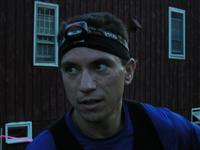 I finally reached the handlers’ station at mile 95, where Mark and Karen were there waiting. I dropped off my light and visor, and headed out again. A mile or two into my latest stroll, I noticed that my hands and fingers (as far as the middle knuckle) had swollen and turned a dark purplish color. The fingertips were still quite pale. I knew somewhere in the back of my head that there was something that I could do about that, but it wasn’t popping up, so I admired the evidence that what I was doing was actually difficult enough to cause mysterious physical issues, and I wandered on. Vince passed me one last time before I remembered. Edema (swelling) in extremities = not enough electrolytes, and I hadn’t been taking my capsules. A couple of Succeed caps must have worked pretty quickly, as the next time I thought about it, the swelling had disappeared.
I finally reached the handlers’ station at mile 95, where Mark and Karen were there waiting. I dropped off my light and visor, and headed out again. A mile or two into my latest stroll, I noticed that my hands and fingers (as far as the middle knuckle) had swollen and turned a dark purplish color. The fingertips were still quite pale. I knew somewhere in the back of my head that there was something that I could do about that, but it wasn’t popping up, so I admired the evidence that what I was doing was actually difficult enough to cause mysterious physical issues, and I wandered on. Vince passed me one last time before I remembered. Edema (swelling) in extremities = not enough electrolytes, and I hadn’t been taking my capsules. A couple of Succeed caps must have worked pretty quickly, as the next time I thought about it, the swelling had disappeared.
I passed the last (unmanned) aid station, which meant there was only 2.1 miles to go. There weren’t any real mountains left, but there was some trail, which the horses had churned up pretty well. While I would have like to have been there earlier, I was glad that I wasn’t trying to run through it in the dark. After the trail, there was a loop through a meadow large enough so I could see other runners. Vince Devlin was still nearby, as was Ray Mount, who was staggering so badly that I knew I’d pass him. However, before I did that, I was passed by a runner and his pacer who were jogging along talking, with little apparent effort involved. Good for them, but if they could run that well, what were they doing back here with me?
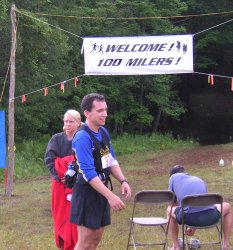 At the end of the meadow, there was someone waiting as we got back onto forest trail. The runners asked him how far it was to the finish. He told them 10 minutes walking, or four at their pace. It ended up being closer to 15 minutes, after some bizarre twists in the trail that had to have been added just to bug me, but finally I could see the gap in the trees leading to the banner at the finish. The ground was soft enough, and what adrenaline remained was flowing, so I managed to run the last 20 yards or so, and I was done! in 27:29:24 (134th, not even first Charbonneau).
At the end of the meadow, there was someone waiting as we got back onto forest trail. The runners asked him how far it was to the finish. He told them 10 minutes walking, or four at their pace. It ended up being closer to 15 minutes, after some bizarre twists in the trail that had to have been added just to bug me, but finally I could see the gap in the trees leading to the banner at the finish. The ground was soft enough, and what adrenaline remained was flowing, so I managed to run the last 20 yards or so, and I was done! in 27:29:24 (134th, not even first Charbonneau).
Due to my confusion while getting to mile 95, it appeared like I was slowing down, so I actually got to the finish a little faster than Mark and Karen had expected, but they were there to take pictures and share in the joy and relief. Somebody had won the race, the previous day, in just under 15 hours. Think of him as a Kenyan (though he’s from Massachusetts), someone running an entirely different race. I started out running with a time in mind, but ended up just surviving. Those last 23 miles had taken over 9 hours.
On this day, that was fast enough for me.
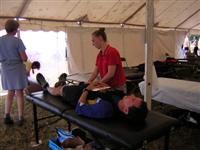 I was toast. It would have been nice to hang around and socialize, and maybe stay for the brunch and awards ceremony, but lying down on my motel room bed was just too appealing, and Mark and Karen were ready to get some sleep too. I checked to see if I could pick up my plaque (nope, not yet), took advantage of the free massage in the medical tent (making Mark and Karen wait, but I couldn’t turn down free massage), and then we drove back to the motel.
I was toast. It would have been nice to hang around and socialize, and maybe stay for the brunch and awards ceremony, but lying down on my motel room bed was just too appealing, and Mark and Karen were ready to get some sleep too. I checked to see if I could pick up my plaque (nope, not yet), took advantage of the free massage in the medical tent (making Mark and Karen wait, but I couldn’t turn down free massage), and then we drove back to the motel.
We said goodbye and I fell down. Sleep would have been nice, but dozing was the best I could do, as any movement woke me up again. After awhile I got up, showered, and assessed the damage. There was some chafing and a few blisters, but nothing so bad that it really had any effect on my race. My feet were rather beaten, but that was expected. Both big toes were going to lose their nails, and the right one would need to be drained once things settled down. My kneecaps were both tender and sore. What was worst were my quads. For the next few days, getting up after any sitting at all was a challenge. It would take a minute to warm up some before I could be sure I wouldn’t fall down. By Tuesday, the worst of that was over. As I write this (a week later), my quads, along with my knees and feet, are still a little sore.
The race has to be considered a success, as I did finish. About one third of the 241 that started didn’t. I learned many things which will help if I ever do this again, and I still haven’t buckled, so chances are good that I’ll have to.
First and foremost, there was my crew. Karen and Mark were wonderful! They were the foundation upon which everything rested. They were always there on time waiting for me, which is harder than you might think. Everything I needed that was possible to get was provided cheerfully. They were encouraging without being saccharine, and familiar faces in an intimidating new environment. I can see the point of purists who try to do these races without a crew, but having someone to share the experience with makes it all better, along with making it possible (for me). I can only hope to be so lucky in the future.
Somehow, I need to get better at running downhills. My quads gave up well before my endurance was exhausted. Stronger quads would help, but not tearing them up in the first place would help more. Also, after losing the ability to run downhill, it might have been useful to try running uphill for awhile, though that would increase the risk of running to exhaustion. This idea never crossed my mind until well after the race was over.
Getting through the aid stations faster could easily save a big chunk of time. I spent well over an hour, maybe as much as two hours, sitting, resting, and collecting the determination to move on. Less rest during the race might hurt in other ways, but there’s plenty of room for improvement.
Changing shoes was useful, and softer shoes might have helped, but stick with the shoes that fit (duh!). Having a slightly larger pair for later in the race is a good thing.
I needed to take enough electrolytes. It would have been useful to set my watch to beep every half-hour to remind me about them. That’s a part of keeping things simple, which is important as I did get stupid as the race went on.
I was never able to eat real food, which might have been useful. I’m not sure why. It could have been caused stress, the ibuprophen, coffee, insufficient electrolytes, or a combination of these. The carbohydrate gel was enough to survive on, but it wasn’t satisfying, and more protein might have helped extend the useful life of my quads.
The old adage, “start slow, the ease off” definitely applies. If I can’t learn how to run better, I’ll have to learn how to run easier. Lining up closer to the front at the start would help, as it would reduce the temptation to pass slower runners early in the race.
The chafing, blistering, etc… wasn’t bad, but could have been managed better. If the weather had been worse, this would have been much more of a problem, but I was pretty dry (except for sweat) most of the time.
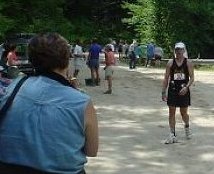 The icewater mitt that Gil’s had would be a great addition to my crew’s kit. Another useful thing would be a small cloth bag for ice to go under my hat when it’s hottest. We tried a plastic sandwich bag, but a bag that lets icewater leak out slowly would be much better.
The icewater mitt that Gil’s had would be a great addition to my crew’s kit. Another useful thing would be a small cloth bag for ice to go under my hat when it’s hottest. We tried a plastic sandwich bag, but a bag that lets icewater leak out slowly would be much better.
The one most important thing I learned was how difficult a 100 mile race really is. Next time I won’t have the need to finish keeping me going, since I’ve already done that. This experience will help me better prepare for the inevitable low spots that occur, and hopefully, help me avoid enough of them to buckle next time.

It was pretty cool to crew for you…I think it says a lot about inner fortitude that you could wrestle the “I should quits” and not.
The image of runners making forward progress down dirt roads at 2 am/3 am was pretty surreal, and one that will be forever in my head
Hope you don’t mind, I kind of scanned this for the important parts…blah, blah, blah Mark blah, blah, blah, Mark and Karen, blah, blah, blah, then Mark…
🙂
I agree with Karen, this is not an event easily forgotten for anyone involved. I’m just glad I didn’t have to complete the whole thing. And it’s still amazing you did.
Pingback: Bookmarks about Trailers